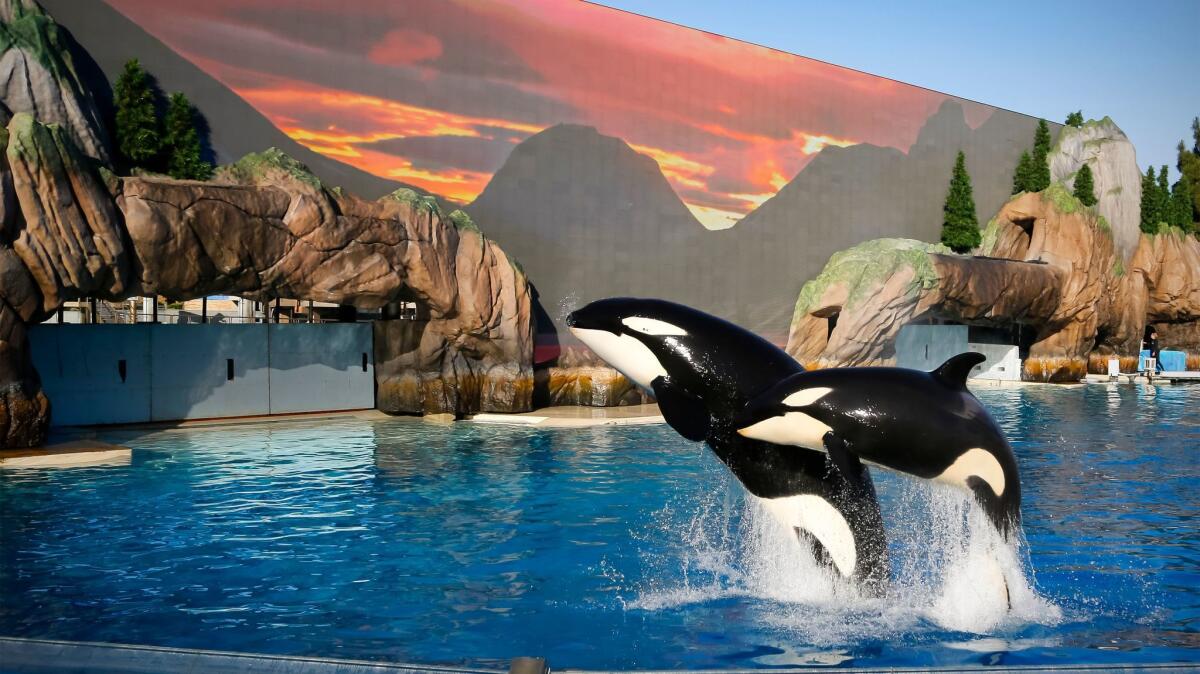Focus: Will new killer whale encounter resurrect SeaWorld?
- Share via
Music up. A symphonic score fills the former Shamu Stadium at SeaWorld, the tempo building suspense as footage of an icy landscape in Antarctica moves across a 140-foot wide screen.
“Get ready for a Keet fast swim,” a director forewarns the killer whale trainers.
A little off cue, the 8,000-pound orca appears, speeding along the perimeter of the pool as waves of water crash over the glass barrier where a crowd of guests would normally be watching the San Diego park’s new Orca Encounter. On the wide screen above, killer whales in the wild work in tandem to also manufacture waves, dislodging their prey — a lone seal perched on an ice floe.
“Keet is demonstrating this wave-making technique,” informs a trainer, “showing the complex and impressive hunting abilities killer whales have developed around the world.”
The hunting demo is but one of many whale behaviors seen in the wild that are being reenacted as the San Diego marine park prepares to debut the much anticipated Orca Encounter this Memorial Day weekend.
SEAWORLD TIMELINE: Ups and downs over the years
San Diego is the first of SeaWorld’s three namesake parks to introduce the new 22-minute-long killer whale experience, following the announcement last year that their Orlando-based parent company would be phasing out the Shamu shows, a fixture here for more than half a century.
The early rehearsals 10 days ago were still being perfected as the trainers practiced guiding the gargantuan orcas through movements meant to sync up with stunning National Geographic-style video displayed on a new infinity, high-definition screen. Also newly installed is a backdrop meant to mimic a rugged coastal inlet in the Pacific Northwest.

“It’s still a work in progress,” reminds a SeaWorld staffer, watching the first complete run-through of the new attraction.
The same could be said of SeaWorld the company, which has struggled the last several years to regain its financial footing as it navigated one public relations crisis after another. While rival theme parks saw steady growth, SeaWorld’s stock fell sharply, revenues slowed and attendance in San Diego dropped amid the public’s rapidly changing sentiments about animal entertainment and care.
Call it the “Blackfish effect,” shorthand for the fallout from the repeated airing on CNN of the 2013 anti-captivity documentary Blackfish.” The film used as its centerpiece the now deceased killer whale, Tilikum, responsible for the 2010 death of SeaWorld Orlando trainer Dawn Brancheau.
RELATED
SeaWorld’s Shamu show delivers last splash
SeaWorld plans $175 million in new attractions
SeaWorld announces new coaster
After just a year on the job, SeaWorld Entertainment CEO Joel Manby announced last March that not only would the company be phasing out the theatrical killer whale shows but it would also end all captive breeding of orcas, a decision that stunned even “Blackfish” director Gabriela Cowperthwaite.
With its debut this Saturday, Orca Encounter marks a pivotal milestone in the reinvention of SeaWorld the brand.
The company boasts that this year it is opening $175 million worth of new attractions at a number of its 12 U.S. theme parks, representing one of the heftiest capital investments in more than 50 years.
In addition to Orca Encounter, which will educate its audiences on how killer whales communicate, socialize, hunt and contribute to scientific research projects, the San Diego park will unveil a new area, Ocean Explorer, themed around underwater exploration. The centerpiece of the family-oriented attraction will be Submarine Quest, a three-minute ride that transports riders in six-seat mini subs outfitted with interactive screens that rely on “smart play” technology developed just for SeaWorld.
And in a big change for the San Diego park, nightly summer fireworks will be no more, replaced with Electric Ocean, a new nighttime attraction that includes an illuminated parade and will start mid-June.
While it’s no Disney or Universal — Manby himself will acknowledge that — SeaWorld wants to prove that not only does it still genuinely care about the ocean and the animals that populate it but that it can once again entice sizable crowds with the help of cool rides showcasing the latest, cutting-edge technology.
“If we just had live entertainment, we couldn’t make it,” Manby stresses. “It’s important to have a mixed experience for the whole family and given there’s some risk on animals and entertainment, you have to diversify. Everything we do at our parks has to be fun and meaningful, but it has to be fun first or people won’t show up. And we know that the millennials and those coming behind them want that kind of company to be behind.”
Trying for a comeback
Manby, who arrived at SeaWorld a little more than two years ago to help engineer a comeback after the previous CEO stepped down, is clear about the company’s near- and long-term goals but says he gets the confusion some are feeling about the theme park company’s future direction. His frequent mantra these days is that SeaWorld is moving away from animal entertainment to “experiences that matter.”
“Anytime a company tries to pivot and transition, there’s always that middle spot where you’ve made a decision and it needs to be crystallized,” Manby said. “I’d say a year from now everyone will be a lot clearer on that as a message. We’ve always had experiences that matter but admittedly we marketed ourselves primarily as animal theatrical shows leading with Shamu, even though we were always a great rescue organization. But that’s how people perceived us.”
The SeaWorld brand, he emphasized, will be an amalgam of multiple pillars, from animal exhibits that are more educational to animal welfare-themed rides and the increasing use of virtual reality to deliver experiences and creatures that wouldn’t be possible in a zoo or aquarium environment.
And that’s all in addition, he says, to staying true to the company’s animal rescue work and more recent initiatives it’s undertaken with a former adversary, the Humane Society, to protect the environment and end practices like shark finning.
Southern California-based theme park expert Robert Niles said he still is left wondering what exactly is SeaWorld morphing into.
“Their identity used to be these spectacular live animal performances, but if SeaWorld is moving away from that, what are they moving toward?” said Niles, founder of Themeparkinsider.com.
“Even in its current state, SeaWorld remains one of the great zoos in the world for marine mammals, but how big is that market relative to what they’re now trying to go after with with thrill rides and attractions that appeal to theme park fans? They need something that people associate with when they hear the word SeaWorld, and it can’t be the place that used to have Shamu.”
Still, signs of a turnaround, at least in San Diego, are starting to emerge. After three years in a row of sometimes steep declines in attendance, visitation at the park was flat in 2016, while down slightly for the company as a whole.
Globally, the theme park company has forged partnerships to expand its brand via new parks in the Middle East and Asia — minus the whales. Just last week, SeaWorld announced it is planning a second Sesame Street-themed amusement park to open somewhere in the U.S. by 2021 as part of its longstanding partnership with the nonprofit behind the children’s television series.
Near term, this summer will be a crucial test of whether the company can really reverse the slide.
“We have hit bottom,” says Manby. “I know the numbers are showing it’s stabilizing and turning. I’m certain we’ll be up this year (in San Diego) after launching these new attractions. Texas will turn. In Florida, it’s tougher there. It has nothing to do with the whale issues, its competition may still be an issue there.
“We made good decisions. The research says people are much more favorable to SeaWorld after those decisions. We will still have the whales for a long, long time but these things take time.”
Don’t call it a show
Years before an educational orca encounter was even a germ of an idea, the Shamu show already had undergone a huge transformation, forced upon it by the fatal attack of Brancheau.
After that, trainers never again returned to the water.
Once resembling more an aquatic rodeo in which trainers rode astride the orcas and were catapulted into the air, the show, post Brancheau, sent the trainers to the sidelines. There they led the killer whales though a choreographed presentation of back flips, faux kisses and dance-like moves that still were capable of eliciting oohs and aahs from those who filled the 5,500-seat stadium.
The difference now, say SeaWorld behaviorists (the park’s preferred parlance for trainers), is all about context. Orca Encounter guests will still experience those awe-inducing moments of witnessing a multi-ton cetacean leap gracefully out of the pool, slap its tail onto the water’s surface, or land on its side, drenching the front rows of the audience with a gush of water.
But now it will be a teachable moment, not a theatrical one.
In a recent practice session, trainers prepared Corky, SeaWorld’s oldest killer whale, for one of those educational moments as behaviorist Kristi Burtis explained the basics of orca communication, one of six segments of the Orca Encounter.
“Like all animals, killer whales use body language as a form of communication,” she said. “They use pec slaps to show dominance. A mother may use a pec slap to get her calf’s attention.”
“Send breach,” the director instructs.
“But if they really want to be heard,” Burtis resumes, “they breach.”
Corky obliges with a gigantic, audience-soaking splash.
In the hunting chapter of the attraction, the audience will learn that a killer whale’s prey is as varied as herring off Norway or a blue whale that is 50 times heavier than an orca.
Orca Encounters will also highlight, through video clips, graphics and whale behavior in the water, recent research involving the resident orcas, like a study of how toxins can be transferred from the mother’s milk to her calf.
“It’s things that seem like human-type behavior that have been omitted and that don’t serve the educational story line,” explained Al Garver, a former trainer and now vice president of zoological operations. “For example, the whales won’t wave at the audience, but we will have them bring their pectoral flippers up and essentially wave, and that shows the pectoral flipper, how it can move, how it’s used for steering and stopping, and it’s always used as a form of communication by slapping it on the water.”
As much as some of SeaWorld’s most devoted fans have objected to the end of the iconic Shamu show, many others are eagerly anticipating the arrival of its replacement, believes Eric Davis, who started the Facebook fan page, Stand With SeaWorld, in 2014.
He’s convinced of that, despite a spate of recent comments on a post on his Facebook page skewering Manby for the change of course on orcas.
“I think Orca Encounter will be a great new experience, I just wish it wasn’t wrapped in the same packaging as ending orcas in human care,” said Davis, a SeaWorld loyalist since first visiting the park in 1989 when he was 8. “The Shamu shows have always changed. Shamu Goes to College was very different from Believe.
“SeaWorld still needs to cater to the broadest demographic possible and that means more rides. I just don’t want them to lose the animal connection aspect.”
In San Diego, Submarine Quest and next year’s Electric Eel coaster are part of SeaWorld’s strategy to elevate the fun quotient for both young families and thrill-seeking teens and adults.
Even as SeaWorld continues to aggressively cut costs — it laid off 320 employees last year — it is rolling out attractions at a much faster clip than in years past, all part of the company turnaround plan, says Brian Morrow, vice president of theme park design for SeaWorld Entertainment.
Ever-evolving innovations in technology are also crucial to SeaWorld’s longevity, whether it’s transforming the Orlando park’s Kraken roller coaster into a virtual reality experience or creating “adaptive smart play” for the submarine ride in which young explorers’ underwater odysseys are customized based on their aptitude.
Later this summer, San Diego will make its own foray into virtual reality with Orca360, a way to feel at one with the killer whales and their trainers under water while never having to leave the comfort of a swiveling chair.
What began as an investment in a two-person startup who created an underwater, 360-degree camera evolved into a new boutique attraction (there’s an added charge) that could expand beyond the San Diego park, said Morrow.
“This is SeaWorld being experimental,” he said. “You’re seeing us set ourselves up for the future. SeaWorld will never become an all digital experience, but it enhances our real life stories. Our big focus is to readjust the park balance and make sure we have enough thrill. It’s like recess. You can’t go to school all day and not have any fun.”
Blackfish effect
Just days before the limited release of “Blackfish,” SeaWorld took the unorthodox step of sending a point-by-point critique of the documentary to 50 critics. It was the first of many moves, regarded by some crisis communications experts as ill-advised, that the company made to blunt the cascading reactions to the film and a growing chorus of detractors.
A little more than a year later, Southwest Airlines would end its 25-year marketing partnership with SeaWorld, and by the end of that same year, former CEO Jim Atkinson resigned. Come early 2015, still in the throes of a financial meltdown, the company launched an advertising campaign, including TV commercials in which earnest-looking members of SeaWorld’s zoological staff talk about how deeply they cared about the killer whales.
It wasn’t enough. In March of last year, SeaWorld announced what Manby has since called an “incredibly difficult” decision: The current generation of SeaWorld’s 29 orcas would be its last.
“When I heard that, my jaw dropped,” recalled “Blackfish” director Cowperthwaite. “That was the last thing I expected to go because nothing is more valuable in the parks than a baby Shamu.
“This was a major sea change and I really do want to acknowledge that but I just don’t want everybody to get too comfortable with it. We still have sentient animals swimming around in concrete tanks. You’ve got a whole generation of kids asking much tougher questions than our generation did. Those are the people that the SeaWorlds of the world need to be more beholden to.”
Cooperating with critics
There was a time not so long ago when the Humane Society of the United States was among SeaWorld’s harshest and most vocal critics. Wayne Pacelle, CEO of the animal protection nonprofit, recalls feeling wary before meeting a couple of years ago with Manby and mutual friend John Campbell, a former Orange County congressman, at a Wolfgang Puck restaurant in Washington, D.C. to discuss the possibilities of finding common ground.
“It wasn’t like someone was going to charm me and I’m going to forget why I was there,” said Pacelle. “I said, ‘Listen, we get the difficulty of putting orcas in sea pens, but what needs to stop is bringing more animals into those captive settings.’ He clearly was ready to talk. I don’t think he was dragged to the table.”
A detente was eventually reached, which included a pledge by SeaWorld to spend $50 million in the fight to end shark finning and the commercial killing of whales and seals. While Pacelle knows he still has to pick his battles, he hasn’t given up on other reforms he hopes SeaWorld will eventually come to embrace. A top priority, he says, would be phasing out the breeding of dolphins.
“I want the company to move toward a rescue strategy for any additional animals it needs for exhibition. I still have a very active relationship with Joel. It would be a fantastic narrative the company could invoke as the second stage of their reform efforts.”
So, too, would retiring orcas to seaside sanctuaries, says Naomi Rose, a marine mammal biologist who formerly worked under Pacelle fighting to free captive orcas. “Blackfish,” she said, was finally able to accomplish what she could not in more than 20 years of activism.
But why stop there, insists Rose, who sits on the board of The Whale Sanctuary Project. Last year, she notes, the National Aquarium announced plans to retire its dolphins to a seaside sanctuary by 2020, although funding through philanthropic contributions must still be secured.
“I’m not trying to antagonize SeaWorld but I want them to see the light,” she said. “There will be a seaside sanctuary for orcas and belugas in the next five years but it won’t be SeaWorld. Instead, they’ll be following.”
As SeaWorld prepares for the day when orcas no longer inhabit the parks, it will gradually become more theme park than a zoological enterprise, predicts theme park analyst Bob Boyd of Pacific Management Group.
“Two years ago, I would have said SeaWorld was in a negative spiral and would have a difficult time navigating their way out of it,” he added. “I think Manby is adapting the current parks into a type of experience that is less expensive, more regional and much more sustainable. It’s probably the brightest outlook SeaWorld has had in many years, although they have many challenges ahead of them.”
Business
lori.weisberg@sduniontribune.com
(619) 293-2251
Twitter: @loriweisberg
More to Read
Inside the business of entertainment
The Wide Shot brings you news, analysis and insights on everything from streaming wars to production — and what it all means for the future.
You may occasionally receive promotional content from the Los Angeles Times.











